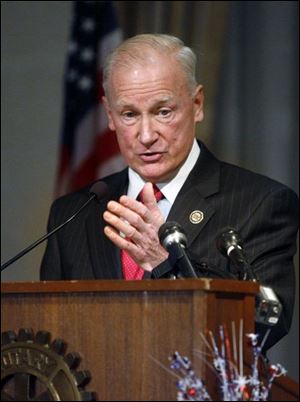
Thousands added to Toledo census count
1/14/2009
Finkbeiner
Toledo successfully challenged the U.S. Census Bureau s population estimate, which puts the city back over 316,000 people a number greater than the official 2000 Census count.
Mayor Carty Finkbeiner, who announced the new figure yesterday, initiated a challenge after the Census Bureau listed Toledo s 2007 population estimate at 295,029 down 0.9 percent from the 2006 estimate of 297,806.
The new July, 2007, estimate will be revised to 316,851. The 2000 census listed Toledo s population at 313,782.
Our investigation into Toledo s true population was a long and arduous process, Mr. Finkbeiner said.
Mr. Finkbeiner thanked Social Compact Inc., a Washington-based nonprofit organization, for its assistance verifying the city s housing data.
The company aided the city free of charge, he added.
Social Compact President John Talmage said Toledo could realize $50 million over 10 years in additional funding from the increased estimate.
To arrive at the new figure, the Finkbeiner administration examined building permit data and net increases in the number of newly constructed and converted housing units from 2000 to 2007. The city also investigated the estimated number of mobile-home units and estimated group home population.
I guess I thought the chances of city hall winning against the federal government were slim to none, Mr. Finkbeiner said.
The mayor last summer announced his effort to challenge the 2007 estimate as well as count more Toledoans for 2010, which is the next U.S. Census. In July, he created the Toledo s 2010 Everyone Counts Committee, a blue-ribbon group that will work to ensure every resident in the city is counted during the 2010 census.
In November, the mayor renewed his public skepticism of the Census Bureau s estimate.
Having a higher population is important because communities get a percentage of federal dollars based on population. The increase in population would bolster the city s chances to acquire funding from President-elect Barack Obama s planned stimulus package, Mr. Finkbeiner said.
Gregory Harper, a demographer with the Census Bureau, said Toledo correctly provided more data on housing units.
In 2007, 61 political subdivisions nationwide successfully challenged their 2006 census estimates, including Detroit, which went from 871,121 to 918,849 people, and St. Louis, which went from 347,181 to 353,837.
Cincinnati reversed years of decline through a challenge of the census estimate in 2005 and had its 2005 census estimate of 308,728 revised to 331,310. Social Compact was hired by Cincinnati for that challenge.
New York challenged its population estimate for three consecutive years, each time receiving a bump.
Toledo, Cleveland, Dayton, and Akron all lost population in the original 2007 estimate over the 2006 figures. Cleveland lost 5,067 in that period, the nation s greatest decline.
Calvin Lawshe, director of the Toledo-Lucas County Plan Commissions, praised the mayor for pushing the issue so aggressively.
Mr. Lawshe, a co-chairman of Toledo s 2010 Everyone Counts Committee, said they would work to make sure all of Toledo s residents are counted in the 2010 Census.
Contact Ignazio Messina at:imessina@theblade.comor 419-724-6171.